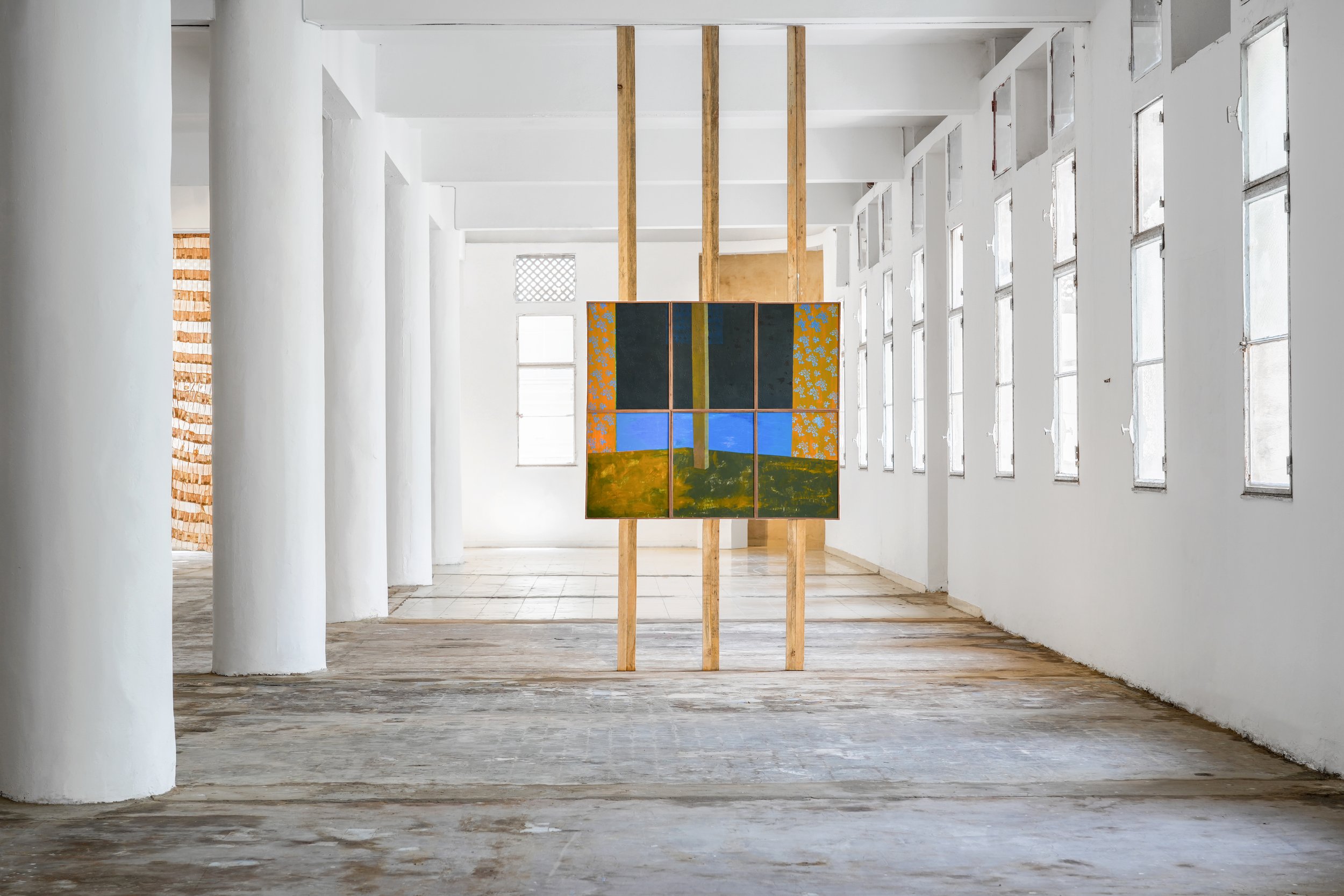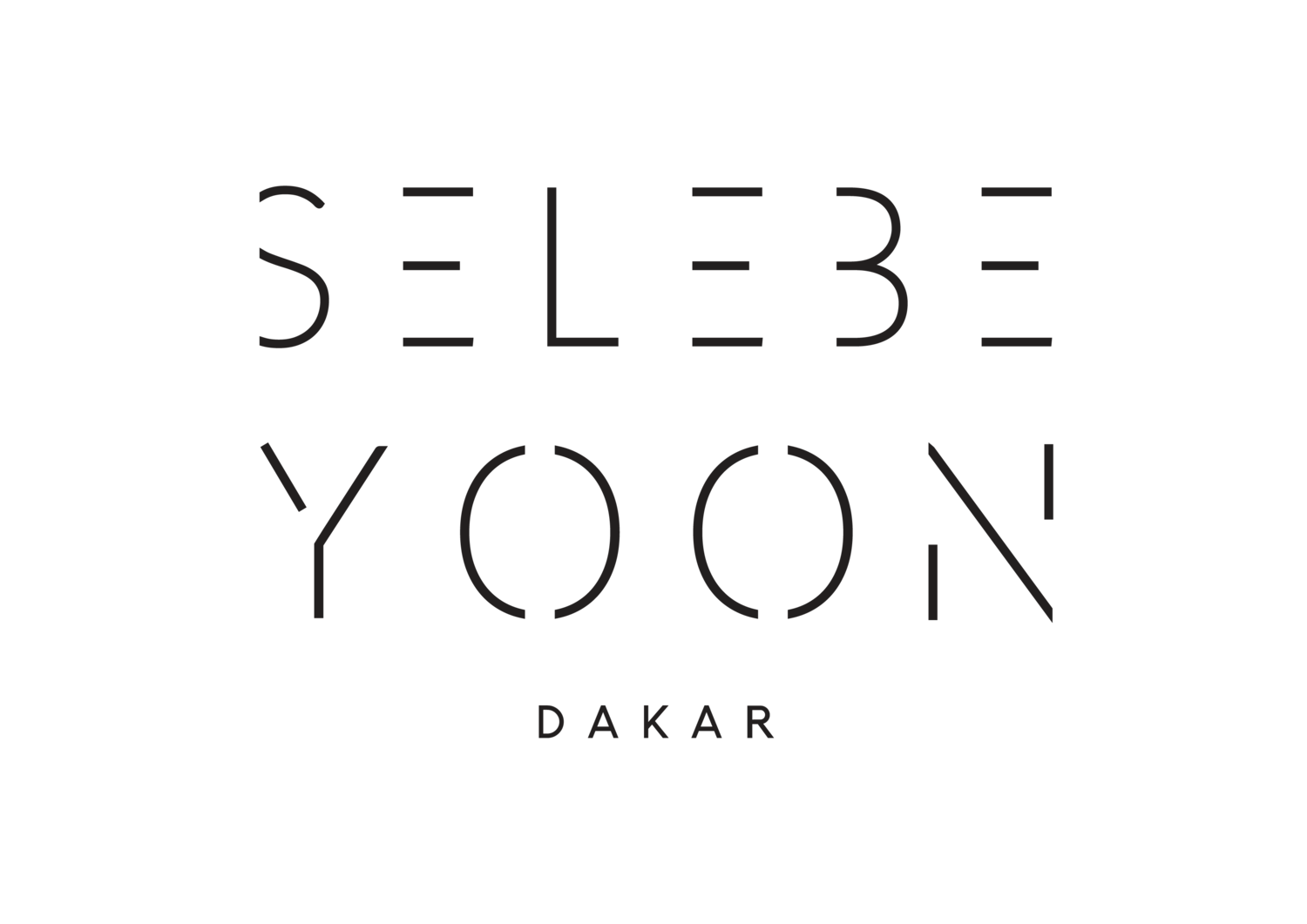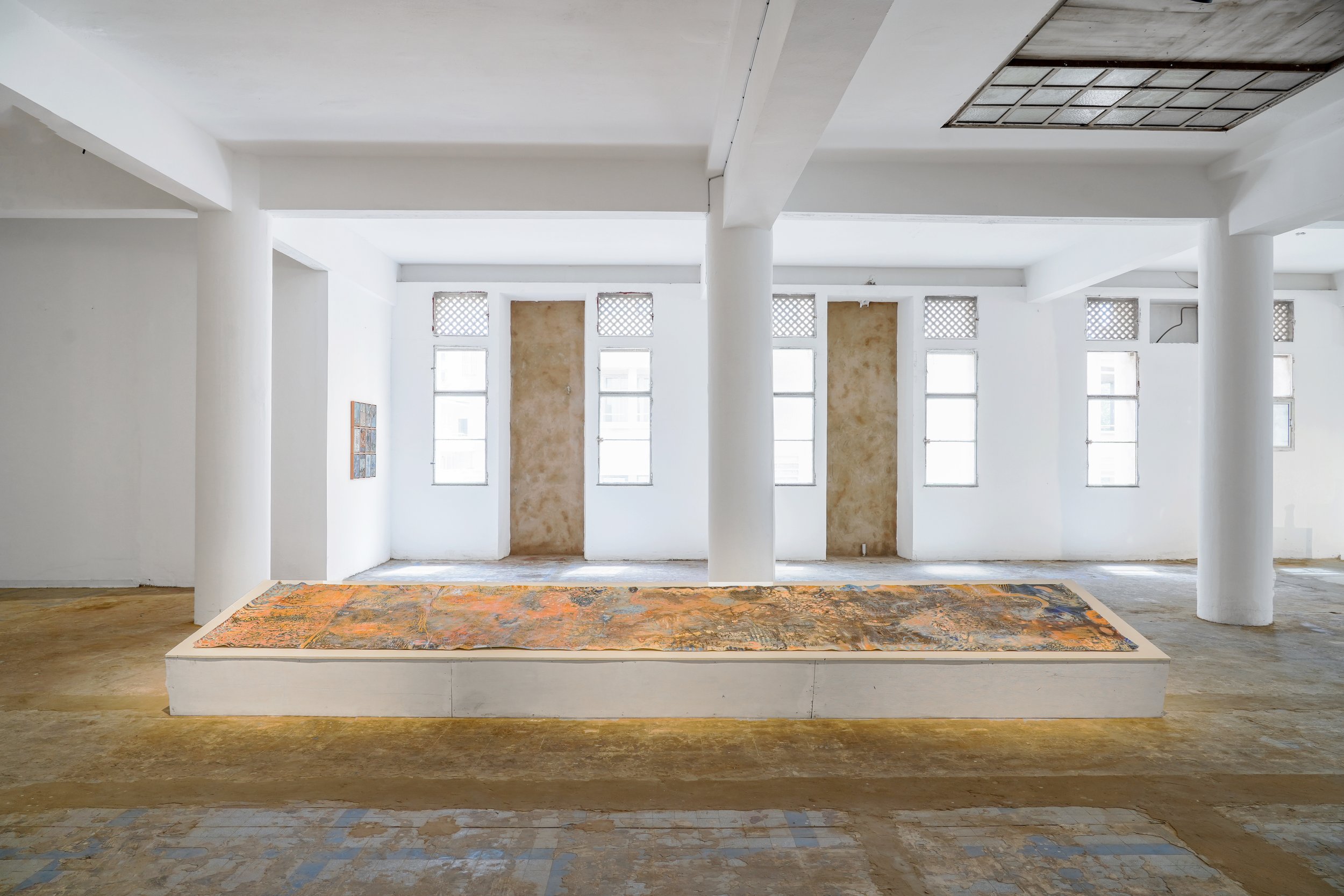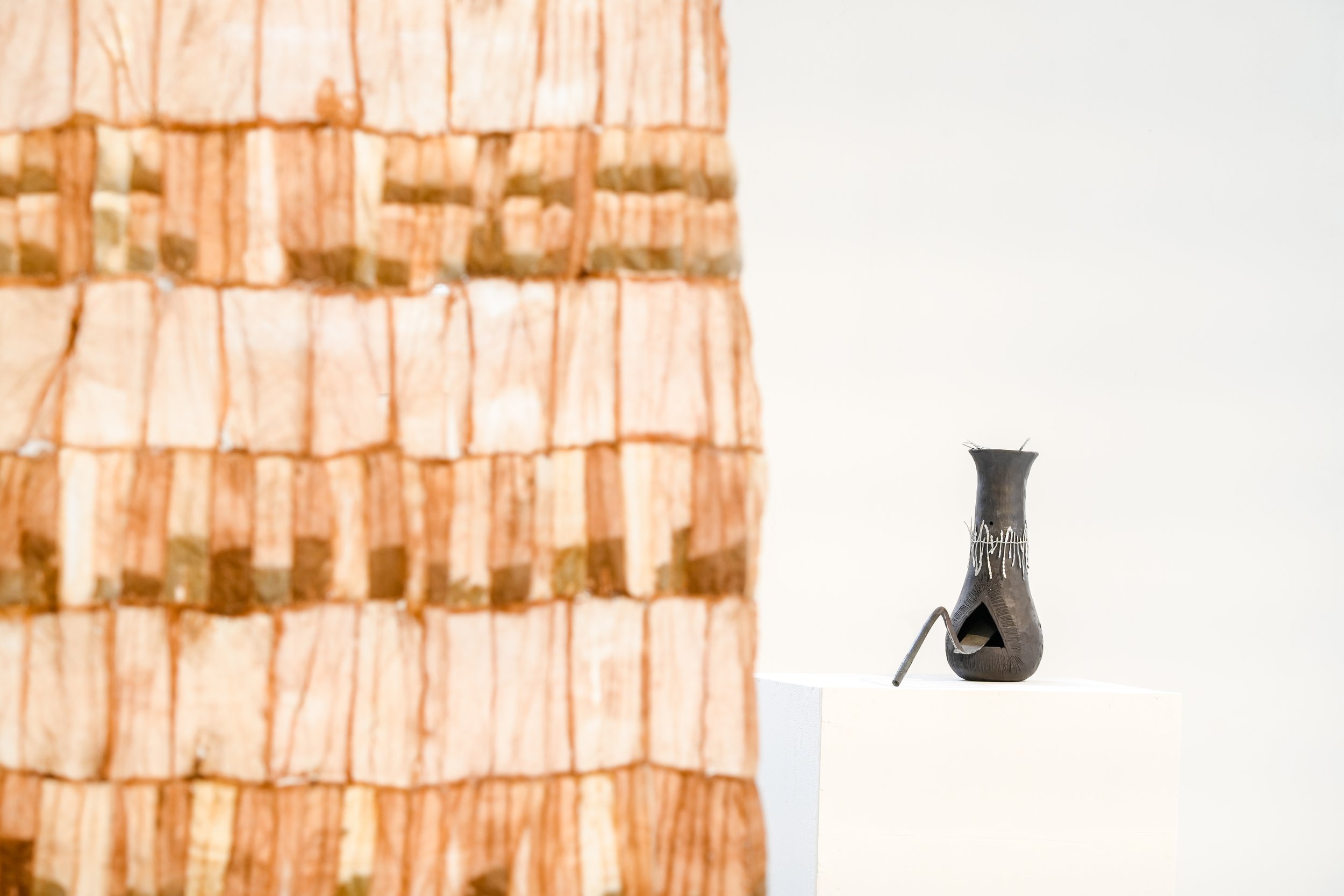
May 15th - July 27, 2024
Entre Parenthèses
Arébénor Basséne
Alioune Diouf
Melinda Fourn
Naomi Lulendo
Sandra Seghir
Entre Parenthèses
Selebe Yoon is pleased to announce its upcoming collective exhibition “Entre Parenthèses”, opening on May 15, 2024 from 6 pm to 10 pm. Featuring the works of Arébénor Basséne, Alioune Diouf, Mélinda Fourn, Naomi Lulendo and Sandra Seghir, the exhibition will take place in the temporary extension of the existing gallery space.
Naomi Lulendo
In her work, Naomi Lulendo explores the way certain bodies, objects and architectures are perceived, testing their ability to place themselves in a new relationship with history and the present. In different cultural and geographical contexts, both real and imagined.
Her works in the "Panorama" series show the artist's interest in interior spaces, an imaginary home, and their link to one or more identities, and in these paintings, with their palpable geometric immobility, columns, clerestories, angles and windows, she evokes an architecture of places with a warm, humid climate, like Lulendo's native Guadeloupe. Oscillating between a place lived in and a place dreamt of, the vanishing lines of the perspectives collide with a thicker texture on the surface: flower motifs that cover the canvas gradually dissipate into the background. Recurring motifs in the artist's work, here cancelling out the separation between interior and exterior, intimate and public, they explore in these works the aesthetic and symbolic links between the body, clothing, cladding and architecture, and bring the landscape into the interior space. The artist plays with visual ambivalence, the notion of transparency and slippage, opacity and reflection, subverting background and surface in a spatial and temporal confusion.
Alioune Diouf
In a monumental work entitled "Mémoire des Ancêtres", Alioune Diouf unveils an assembly of figures - like spiritual icons. Looking straight at the viewer, some in profile in the manner of Egyptian figures, others anthropomorphic with bird heads, these figures of timeless quality are endowed with sumptuous finery and ample tunics celebrating the West African style of dress. The artist's pictorial universe is characterized by the intermingling of characters, a fantastical bestiary, cosmic motifs influenced by Serer philosophy, and suggests the silhouettes of ancient Egyptian or Ethiopian art. To embroider the fabric sewn onto the canvases, Alioune Diouf uses the Cornely, a hand-guided embroidery machine - the result is more akin to an embroidered drawing.
A work from the same series is in the La Maison des Esclaves Collection, supported by the Ford Foundation.
Sandra Seghir
Sandra Seghir, a Lebanese-Guinean painter based in Dakar, weaves multiple narratives into her work, questioning the relationship between individual and collective memory. From history to mythology, archival images to current news, she attempts to establish a pictorial language specific to her mystical vision of the world. In "Sound of Pacific Revolution", Seghir explores the role of art and music in the resistance movements of West African independence. The presence in the painting of Nigerian artist Fela Kuti, a major figure in the Nigerian musical heritage recognized as the inventor of Afrobeats, pays tribute to his musical, spiritual and political universe. This figure, visible in the top right-hand corner of the work, points his finger at the crowd, like an injunction to revolt through music.
All the elements of the canvas seem to respond to an ecstatic burst of movement. In a celebration of the natural world and its elements, an immense wave envelops all the figures, while a flaming brush-like instrument emerges from a sea turtle - like a peaceful weapon. In this tangle of symbols, white statuesque figures similar to classical European sculptures face polychrome West African masks, raising the question of an aesthetic segmentation linked to the North-South relationship. In a vibrant palette, mysterious, almost ghostly presences lodge themselves within the canvas's protagonists, like the invisibles of bygone times, and evoke for the artist the idea of orality, of movements and sounds inscribed in a genetic code. The body, a seismograph of all past sounds, becomes a place of memory. So she asks herself: what might the sounds of revolution look like in painting? How can we translate the polyrhythm of music through the polychromy of colors?
In her work "Les Voix", the artist proposes a series of circular paintings stretched over sieves, like resonance boxes. The images take as their starting point a reinterpretation of the archives created by the A.O.F (Afrique Occidentale Francaise) of musical ceremonies, as well as the artist's family album, whose maternal aunt, Jeanne Macauley, was a member of the Ballets Africain de Guinée dance troupe created in 1950, which became a cultural and revolutionary symbol following the country's decolonization. The artist hijacks these images, infusing them with their original movement, reversing the dynamics of the bodies in a gesture of reappropriation. Like sound waves, in unique shades of black, white and gray, these capsules resemble fragments that evoke the fragility of preserving traditions in an age of modernization and digital progress.
Arébénor Basséne
Arébénor Basséne's new "Equinox" series refers to the astronomical term for the moment when dawn equals dusk, day equals night. This new abstract constellation consists of pieces made on paper and mounted on canvas. In a certain spatial and temporal confusion, our gaze shifts from one unit to another, microscopic visions of earthly materials transform into macro perspectives of geographical zones, relief representations, deltas, desert dunes and river courses - a nocturnal geography takes shape. Cracks and folds in textures conjure up raw visions of material such as rock strata, geological faults, earth and sand - visions that evoke both real and imaginary landscapes. Each work, made on kraft paper mounted on canvas, contains a variety of materials: gum arabic - the raw material that made the West African coast so attractive to foreign sailors - as well as the ink used for Koranic tablets, fouden (henna), wood residues and natural pigments from the Dakar region. His monumental canvas "Wild Sahelian Paradise" contains just as many diverse materials, and resembles a utopian cartography.
Mélinda Fourn
Originally from Benin, Melinda Fourn grew up in France and studied at the Beaux-Arts in Paris. Following a university exchange to Ghana, with the Kwame Nkrumah University of Science and Technology in Kumasi, she chose to settle in West Africa, between Senegal and Ghana. From sculpture, photography and poetic writing to multimedia installations, she is interested in West African craft skills such as weaving, braiding, ceramics, jewelry and metalwork. Her work, "Plaine ocre" (Ochre Plain), made from a large number of consumed tea bags, machine-sewn and hand-sewn by the artist herself, is transformed into an olfactory curtain with ochre tones. Alternating between filled and emptied tea bags, the piece evokes the shapes of Ghanaian fabrics such as Kenté.
Addressing the question of heritage, the transmission of traditional know-how and issues related to the body, jewelry and ornamentation play an important role in the artist's sculptural works. Melinda Fourn translates traditional West African jewelry such as earrings, necklaces and fans into new materials, which she stages at different scales, in order to divert, decorate and magnify them. Bringing them to life in iron also means perpetuating them in a solid material, at a time when many skills are disappearing in the face of industrialization and the massive importation of foreign products. Oscillating between homage to tradition and emancipation, she invests this floating space in which objects exist: between the material and transcendental worlds, the domestic and the public, the intimate bodily and the sacred spiritual.
Artists biographies
© Morel Donou
From Southern Senegal in Casamance, Arébénor Basséne was born in 1974 in Dakar. Fascinated by ancient civilizations, whether dreamed of or forgotten, from the great empires of Africa to those of the Mediterranean, it is nevertheless the stuttering of history that gives birth to Arébénor Basséne’s artistic practice, built as imaginary witnesses of the past.
He holds a master's degree in African civilizations and literature (2012-2013), a double degree in English and African civilizations (2010-2011) from Cheikh Anta Diop University and is agraduate of the National School of Arts of Senegal (1997-2001).
Arébénor Bassène, has had solo exhibitions: "Que je naisse, tout doux, semant", presented by Selebe Yoon at L'Atlas in Paris, France (2023) and "Mots de Neige, Histoires en Sable", at Selebe Yoon in Dakar, Senegal (2021).
His work has also been shown in the following group exhibitions : "Sur le fil : broderies et tissage" organised by 19M initially at the Théodore Monod Museum (IFAN), Dakar, Senegal and in their gallery in Paris, France (2023). He represents the Senegalese Pavilion at the Musée des Civilisations Noires for the Dak'Art Biennial, Dakar, Senegal (2022), Participates in OFF at the Havana Biennial, Cuba (2019), "Junction" at the Théodore Monod Museum (IFAN), Dakar, Senegal (2017), at the group exhibition at the Alliance Française in Addis Ababa, Ethiopia (2017), "Regards sur cours" at the Gorée Institute (2017), in the Dak'Art Biennial (2016) curated by Simon Njami, Dakar, Senegal; "Le Sénégal à Paris" presented by the Maison de l'Afrique at the Rotonde de Montparnasse (2011), at the first Cheikh Anta Diop memorial at the Centre Culturel Français (1995).
He has been nominated for the Norval Sovereign African Art Prize, at the Norval Foundation in Cape Town, South Africa, and is one of the finalists in (2023). He won the Dakar City Council prize (2022), the UEMOA - West African Economic and Monetary Union prize (2016) at the Dark'Art Biennial and the Ministry of Culture prize at the 9th National Plastic Artists' Exhibition (2011).
He lives and works in Dakar, Senegal.
© Mamadou Ly
Alioune Diouf (b. 1964, Dakar) is a Senegalese artist, of Serer origins. As a painter and sculptor, he uses a wide variety of materials. He creates his own pigments, sews his canvases and creates sculptures from natural environmental elements. His pictorial universe is characterized by the interweaving of figures, animals, cosmic and floral motifs, as well as by spiritual and sacred symbolism.
He pursued a koranic education while his artistic education happened outdoor in direct observations of the world and in contact with a large community of artists. In 1989, he met the emblematic figure of Senegal in the arts, Issa Samb who invited him to join the famous courtyard at 17 Jules Ferry and became a member of the Laboratoire Agit’ Art, one of the first and most important artist collective founded in 1974 that organized artistic experimentations and performances. Alioune Diouf lived there for 28 years, participating in the improvisational happenings and workshops of the collective, constantly transforming the courtyard while developing his personal practice. In the efervescence of this community, he developed his artistic practice restlessly.
As a painter and a sculptor, Alioune Diouf uses a diversity of materials: he produces his own pigments from clay, kola and cofee nuts and plants, and uses in his works textile scraps and sewing. His sculptures from monumental sand pieces to carved wooden ones, are made of readily natural materials. His pictorial realm is characterized by intertwined figures, animals and cosmic and floral motifs as well as a spiritual and sacred symbolism. In 2020,
Alioune Diouf received a solo exhibition, "Ubeku" at the Selebe Yoon gallery, following a two-month residency. His work was included in several group exhibitions, such as: "Sur le Fil", at Théodore Monod Museum, Dakar, Senegal and Le 19M, Paris, France (2023); "Quand les Arbres s'enracineront dans la Terre" at the Residence of the French Ambassador (Dak'Art Biennale, 2022), Dakar, Senegal; "Teg Bët Gëstu Gi" at Théodore Monod Museum (IFAN), co-organized by art historian Emmanuelle Chérel, Dakar, Senegal among others. With Le Laboratoire Agit'Art, he has participated in exhibitions such as Le Congrès de Minuit (Biennale de Dakar, OFF, 2016) and La Cloche des Fourmis (Biennale de Dakar, OFF, 2018), Senegal. His personal work and collaborations with Issa Samb were exhibited at the Hamburger Bahnof in Berlin, Germany in 2019 in the exhibition "How to talk with birds, trees, fish, shells, snakes, bulls and lions". Diouf did a residency at Meet Factory, a contemporary art center in Prague (2015).
His work is in important public and private collections, including the Beaux-Arts de Nantes, France and the Maison des Esclaves, Gorée, Senegal, as well as in numerous private collections in the USA, Europe and Africa, such as the Jom Collection and the CBH Bank Collection.
Alioune Diouf lives and works in Dakar.
Mélinda Fourn (b. 1995, France) is a French and Beninese artist. Drawing on West African artisanal skills in jewelry, metal, ceramics and weaving, her sculptures and multimedia installations question the social and religious symbolism of everyday tools.
She graduated from the Beaux-Arts de Paris in 2021 and completed an exchange program at the Kwame Nkrumah University of Science and Technology in Kumasi, Ghana (2020).
She participated in several group exhibitions: “Vertigineuses”, Selebe Yoon, Dakar; "The Fire of Origins", Biso Biennale, Ouagadougou, Burkina Faso (2023); "Diversi-T", Kosmokey, La Cité Fertile, Pantin, FR (2023); "Intention", Azz-Art, Paris FR (2022); "Pièce, Habitation, Abri... "Musée Delacroix, Paris, FR (2022); "Restitution" at the Institut Français, Saint Louis, SN (2022); "100% l'Expo", La Vilette, France (2022), among others.
She has benefited from several residencies, including at Selebe Yoon, Dakar (2023) and Villa Saint-Louis Ndar (2022), ArtMéssiamé in Lomé, Togo (2021), Green Patch Ceramics, La Borne, France (2021) and Casa Lü, Ttlaplan, Mexico (2019).
She was awarded the Residency Prize of the Biso Biennale in Ouagadougou in 2023.
She lives and works between Paris (France), Kumasi (Ghana) and Dakar (Senegal).
© Morel Donou
Naomi Lulendo born in 1994 in France, is a French-Guadeloupean-Congolese artist. With a multicultural background, the artist traveled between the Caraïbes and France throughout her childhood. From photography, ceramics, installation and video, she uses the concept of “misappropriation” of words, meanings, objects and identity in her work.
Naomi Lulendo holds an MFA degree from the Beaux-Arts School of Paris (2018). Throughout her education, Pascale Marthine Tayou became her mentor.
She had two solo exhibitions: “Bleu Miroir” at Agences Trames in Dakar (2021); “Faites vos Je” at the Beaux-Arts, Paris (2018). Recently, she presented the performance “Archi(s)pell” at the Le Frac Reims, in France as part of the FAR AWAY Festival (2023).
Her work was included in several group exhibitions: « Dérives en péninsule » at l’Atlas, Paris, France (2023); « D’ailleurs je viens d’ici » curated by Sandrine Honliasso and Ariane Leblanc, at Comédie de Caen, Normandie, France (2021); « On fait des dessins dans la terre » curated by Eva Barois de Caevel, Galerie 31Project, Paris, France (2021); « L’heure rouge » , 14th Dakar Biennale OFF, Galerie Le Manège, Dakar, Senegal (2018); « Extrangers », Tevere Art Gallery, Rome, Italy (2017); « Explosition », Chapitre 2 at Galleria Continua, les Moulins, France (2016); « Transmissions, Recréation, Répétition » curated by Sarina Basta at Palais des Beaux-Arts, Paris, France (2015); « Explosition », Galerie l’Amour, Bagnolet, France (2015); « Transition » curated by Anais de Senneville and Aurélie Tifreau at Galerie L’inattendue, Paris, France (2015); « Ici au lieu de là- bas », Maison des ensembles, Paris, France (2014). Naomi Lulendo also did several public performances: « Archi(s)pell » at the Le Frac Reims, in France as part of the FAR AWAY Festival (2023); at Bétonsalon, Centre d’art et de recherche, Paris, France (2020); Galerie Allen (2019); Raw Material Company, Dakar, Senegal (2018).
In 2021 she was among the artists selected by Zeitz MOCAA (South Africa) to join "Unfinished Camp", an ongoing international network of artists and nine art institutions on six continents, conceived and directed by Hans Ulrich Obrist and András Szánto. She was also a fellow at the Raw Academie for the fifth session, directed by artist Otobong Nkanga; and at Agence Trames, Dakar, Senegal (2021). Naomi Lulendo will exhibit at Selebe Yoon in 2023.
In October 2024, Naomi Lulendo will be included in a group exhibition “Tituba, who protects us?” at Palais de Tokyo, Paris curated by Amandine Nana.
She lives and works between Paris, France and Dakar, Senegal.
© Morel Donou
Sandra Seghir (b. 1993, Lomé, Togo) is a Lebanese-Guinean painter who grew up between Benin and Senegal. After studying drama at the Cours Florent in Paris, she joined Itecom Art & Design, graduating in 2020.
In 2021, she participated in her first exhibition, “L'année d'après”, as part of the Génération A festival at the Théâtre de la Villette in Paris, organized by curator Mohamed A. Cissé.
In 2022, in OFF of the 14th edition of the Dakar Biennial, her work was featured in the group show “Picasso Remix” at Le Manège, the gallery of Institut Français in Dakar, as well as “Taxalé” at the Atelier Concept.
That same year, she was also invited to exhibit as part of “Shout Plenty”, a collective exhibition at the African Artists Foundation in Lagos, Nigeria.
In 2023, she was one of thirteen artists selected for a traveling exhibition initiated by renowned singer Mr. Eazi. On this occasion, her work was presented at Gallery 1957 in Accra, Ghana, and at the 1-54 fair in London.






























